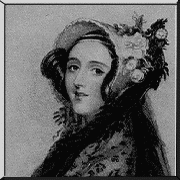 Ada
Byron, Countess of Lovelace,
was born to Annabella Byron (Lady Byron) and renowned poet
George Byron (Lord Byron) in London on December 10th, 1815. Ada's
parents divorced soon after she was born and Ada was raised by her
mother. Lady Byron was quite determined that her daughter not pursue
the reckless life of a poet, as her father did. Instead, she chose
for her daughter an area of study quite the opposite of the one her
ex-husband chose, the field of mathematics.
Ada
Byron, Countess of Lovelace,
was born to Annabella Byron (Lady Byron) and renowned poet
George Byron (Lord Byron) in London on December 10th, 1815. Ada's
parents divorced soon after she was born and Ada was raised by her
mother. Lady Byron was quite determined that her daughter not pursue
the reckless life of a poet, as her father did. Instead, she chose
for her daughter an area of study quite the opposite of the one her
ex-husband chose, the field of mathematics.
Ada continued her study of mathematics into adulthood. At the age of 18 she met mathematician Charles Babbage. She was fascinated by his invention, the Difference Engine. She would later learn about Babbage's next proposed invention, a calculating machine called the Analytical Engine. In 1843 Ada wrote and published "Notes," a detailed interpretation of the Analytical Engine. These "Notes" are considered today to be the world's first computer program. Ada envisioned many capabilities for the Analytical Engine. She suggested that such a machine could be used for scientific and other purposes, such as the production of graphics, and even music. Although the Analytical Engine was never built, the inventors of the ENIAC, the first all-electronic digital computer would use Babbage's ideas in their invention.
Ada married the Earl of Lovelace in 1843 and later had 3 children. Ada's life was plagued with illness, and in 1852 at the age of 37, she died of uterine cancer. Her reputation as a mathematican and the writer of "Notes" was forgotten for 100 years. Then in 1952, her work was rediscovered in a book discussing the history of computing. Since then there has been a renewed interest in her life and work. In 1980 the U.S. Department of Defense named a programming language after her. The "Ada" programming language is still in use today.
Designed by: Michelle Valdez
Baum, Joan. (1986). The Calculating Passion of Ada Byron. Hamden: Archon Books
Ada Byron King website [Online]. Available at http://www.cs.yale.edu/homes/tap/ada-lovelace.html.